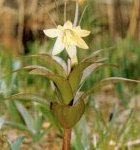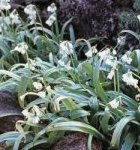 |
QUICK SEARCH
MO PROJECTS:
Africa
Asia/Pacific
Mesoamerica
North America
South America
General Taxonomy
Photo Essays
Training in Latin
America
MO RESEARCH:
Wm. L. Brown Center
Bryology
GIS
Graduate Studies
Research Experiences
for Undergraduates
Imaging Lab
Library
MBG Press
Publications
Climate Change
Catalog Fossil Plants
MO DATABASES:
W³MOST
Image Index
Rare Books
Angiosperm
Phylogeny
Res Botanica
All Databases
INFORMATION:
What's New?
People at MO
Visitor's Guide
Herbarium
Jobs & Fellowships
Symposium
Research Links
Site Map
Search
ORNAMENTAL PLANTS IN THEIR NATURAL HABITATSA. Turkmenistan
The Kopet-Dag range, which is within easy reach of Ashkhabad, is the most interesting western region in montane Turkmenia. The central Kopet-Dag is dominated by herbaceous members of the daisy, pea, and cabbage families. The lily family is also abundant here, and Turkmenian tulips are of special interest for introduction. Tulipa is plentiful in the flora of Central Asia, yielding over 60 of the world’s 100 species. Some tulips are so attractive that they can be considered quite worthy rivals of routinely cultivated varieties. Outstanding Turkmenian tulips with showy red flowers include Tulipa hoogiana and T. micheliana with flower diameters to 15 cm/5.9", T. ingens with even larger diameter to 20 cm/7.8." Also remarkable are species with large but smaller red flowers T. kuschkensis and T. wilsoniana as well as T. turcomanica (subgenus Eriostemones) with white bell-shaped flowers. In addition to tulips, other bulbous plants of Crocus, Fritillaria, Ixiolirion, Merendera and Allium also abound in Central Asia. The most attractive of the onions are Allium giganteum, A. cristophii, A. paniculatum, A. turcomanicum and the Irano-Transcaucasian A. paradoxum. The last has bell-shaped nodding white flowers resembling those of lily-of-the-valley. Nine Eremurus species of desert candle or fox tail lily, grow in Turkmenia, including the white-flowered endemic E. subalbiflorus (100 cm/3,2 ft tall) and pink-flowered E. kopetdaghensis (80 cm/2,6 ft tall), both of which are in cultivation in botanical and private gardens in Central Asia. Two widspread species brown-pink-flowered E. inderiensis and yellowed-flowered E. luteus are very easy in cultivation. Other Kopet-Dag monocots are Hyacinthella litwinowii [=Hyacinthus litwinowii] and Hyacinthella transcaspica [=Hyacinthus transcaspicus] both invaluable for breeding, the local star of Bethlehem Ornitholgalum arianum which flower in very early spring and the winter-daffodil Sternbergia lutea, which flowers in autumn. The family Iridaceae is represented by Crocus, Gladiolus, Iris, Juno and Ungernia of which the most attractive are Iris ewbankiana, I. songarica and Crocus michelsonii. The Orchidaceae of Kopet-Dag are essentially Irano-Transcaucasian taxa, though there are some endemics ones (e.g. Orchis fedtschenkoi). Many other showy species belong to the families Brassicaceae, Caryophyllaceae, Fabaceae, Ranunculaceae and some Asteraceae can be very attractive, e.g. Gundelia tournefortii. The eastern part of Turkmenistan is dominated by the Kugitang (Kugingtau), a mountain range with a flora fundamentally different from that of Kopet-Dag and it represents the eastern boundary for many species that are widely distributed in Turkmenistan. |
||||
| ORNAMENTAL PLANTS FROM RUSSIA |
© 1995-2025 Missouri Botanical Garden, All Rights Reserved
4344 Shaw Blvd.
St. Louis, MO 63110
(314) 577-5100
Technical Support



